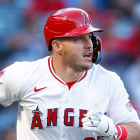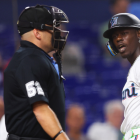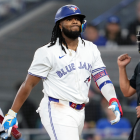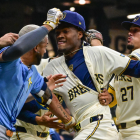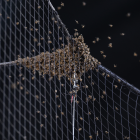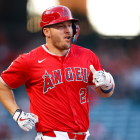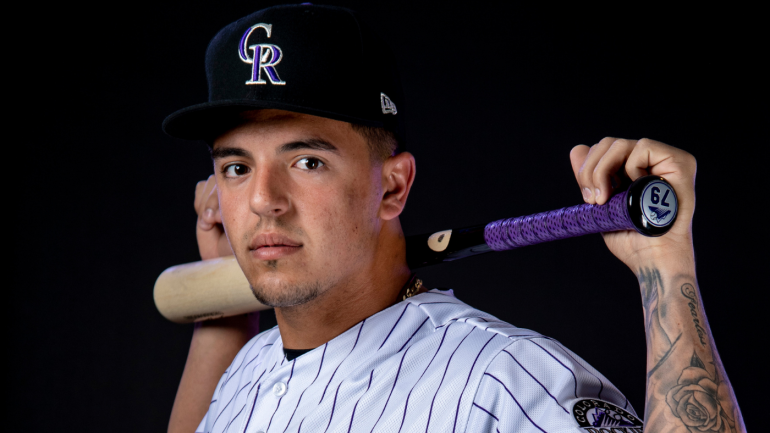
The arrival of the offseason means that it's time to rank stuff. Already this winter, we've sized up the 60 best free agents, both on an overall and positional basis. There's no law that prevents us from ranking minor-league players in addition to their big-league counterparts. As such, we're going to spend the winter evaluating every team's farm system.
The lack of a minor-league season makes that more of a challenge this year. It doesn't help that some teams opted against sharing video and data from their alternate-site camps with the rest of the league. As such, we've opted against overthinking this. Our rankings will essentially be the same as they were last winter with a few changes. First, we'll exclude anyone who graduated by exhausting their rookie eligibility; second, we'll replace them with draftees or other worthy prospects; and third, and lastly, we'll present the information in a new format.
In every article in this series, you'll find a team's top five prospects as well as five others we felt like including, either because of their promise or some other reason. For those top five prospects, you'll find a quick summation of their pros (their saving grace, if one will) and their cons (their fault line), as well as beefier report and our attempt to peg their "likeliest outcome."
These rankings were compiled by talking to industry folks -- scouts, analysts, and other evaluators -- and include a touch of our own evaluative biases. Remember, that this is more of an art than a science, and that the write-ups matter more than the rankings themselves.
Now, let's get on to the top five prospects in the Colorado Rockies system.
1. Zac Veen, OF
Age (as of 4/1/2021): 19
Height/Weight: 6-foot-4, 190 pounds
Acquired: No. 9 pick in the 2020 draft (Spruce Creek High School, Florida)
Highest level: High school
Saving grace: Projection
Fault line: Inexperience
Scouting report: Veen was the second prep bat taken in June's draft; he could've been the first. He's a long, lean left-hander who's certain to draw Kyle Tucker comparisons from now until the time he makes his big-league debut. All the makings of a run producer are present. He has ample bat speed; he has a keen eye; and he has a projectable frame that ought to allow him to add weight and strength over the coming years. The only hiccup there is that Veen will likely have to slide off center as he grows. Oh well. He has enough arm to man right.
Likeliest outcome: Right fielder with power, on-base chops
2. Ryan Rolison, LHP
Age (as of 4/1/2021): 23
Height/Weight: 6-foot-2, 213 pounds
Acquired: No. 22 pick in the 2018 draft (Ole Miss)
Highest level: High-A
Saving grace: Safeness
Fault line: Upside?
Scouting report: Rolison is a polished three-pitch lefty who would likely be knocking on the big-league door had there been a standard minor-league season. He throws strikes with his low-90s fastball; he generates whiffs with his curve; and he keeps right-handers honest with his changeup. The biggest knock against him is that there isn't a ton of flash here. He's not likely to develop into a front-end starter or anything like that. That's fine, though, because he should be a solid No. 3 or 4 starter for some time to come -- beginning, perhaps, next fall.
Likeliest outcome: Mid-rotation starter
3. Colton Welker, 1B/3B
Age (as of 4/1/2021): 23
Height/Weight: 6-foot-1, 235 pounds
Acquired: Fourth-round pick in the 2016 draft (Stoneman Douglas High School, Florida)
Highest level: Double-A
Saving grace: Pure hitting ability
Fault line: Power
Scouting report: The last we saw from Welker, he'd finished his most disappointing pro season. He'd batted just .252 with a .408 slugging percentage in Double-A, and had taken to playing more and more first base. The tension within his profile should be obvious: he's not a good enough defender to handle third base on an everyday basis, yet his lack of power makes it hard to envision him being an asset at the cold corner. Welker has, outside of 2019, hit .300 or better throughout his minor-league career. Some of that has to do with the ballparks he's played in, sure; he's still going to have to regain his stroke if he's going to be more than a bench piece.
Likeliest outcome: Second-division starter or reserve
4. Ryan Vilade, OF/INF
Age (as of 4/1/2021): 22
Height/Weight: 6-foot-2, 226 pounds
Acquired: Second-round pick in the 2017 draft (Stillwater High School, Oklahoma)
Highest level: High-A
Saving grace: Offensive growth
Fault line: Lack of a true positional home
Scouting report: Vilade hails from the same high school where the Rockies found Matt Holliday back in the '90s. Now, he might be patrolling the same position. Indeed, the Rockies intend to have Vilade play primarily as an outfielder, which puts additional pressure on his stick. To his credit, he tapped into his raw power more in '19, lifting the ball and homering more frequently. He'll have to continue that in order to be a starting-caliber outfielder. Our guess is that he'll instead turn into a bat-first utility player who sees action on the grass and dirt alike.
Likeliest outcome: Offensive-minded utility player
5. Michael Toglia, 1B
Age (as of 4/1/2021): 22
Height/Weight: 6-foot-5, 225 pounds
Acquired: No. 23 pick in the 2019 draft (UCLA)
Highest level: Low-A
Saving grace: Power
Fault line: Swing-and-miss
Scouting report: Toglia is a hard prospect to figure out. He's a good defensive first baseman and a switch-hitter with big-time power who hit a combined 26 home runs in 2019 between college and the pros. He also struck out in roughly a quarter of his plate appearances … and that was after he batted .209/.323/.388 with a wood bat in the previous summer's Cape Cod League. There's a lot of variability here, in short. Until he has more time against pro-quality arms, it's unclear if he's going to be able to harness his gifts and meet the demands of the cold corner.
Likeliest outcome: Too early to say
Five others to know
- Drew Romo, C
Romo was considered to be the best defender among prep catchers in the 2020 draft class. He was also considered to be a better hitter than Will Banfield, his equivalent from the previous year. Offensively, he's a switch-hitter with raw power. The usability of said pop is to be determined, but his mitt is such that he won't have to hit a lot to have a big-league future.
- Chris McMahon, RHP
McMahon played three sports in high school, which tells you all you need to know about his athleticism. He could be a quick-moving back-end starter with three above-average offerings at maturation if his body cooperates. McMahon was limited to just 112 innings over three seasons at the University of Miami, missing time with both knee and shoulder issues.
- Grant Lavigne, 1B
Lavigne, the 42nd pick in the 2018 draft, just celebrated his 21st birthday in August. He's already physically imposing to the extent that he wouldn't look out of place in a big-league lineup -- at least not until he stepped to the dish. Lavigne hails from New Hampshire, so it tracks that his developmental road would be longer and curvier than the standard high-school bat. That's proved to be the case so far, as he's struggled to lift the ball so far in his professional career. A first baseman with a .327 slugging percentage is about as worthwhile as a dentist with more cavities than clients. Luckily for Lavigne, he still has time to figure things out.
- Karl Kauffmann, RHP
Michigan has produced a number of high-round starters in recent years, including Kauffmann, who led the 2019 team with 130 innings pitched. The Rockies understandably let him take the rest of the summer off after shouldering the load for the 50-win Wolverines. Unfortunately, the pandemic means that he's yet to make his pro debut. Kauffmann has an above-average sinker-changeup pairing. He'll need to refine his breaking ball to stick as a back-end starter.
- Ben Bowden, LHP
Using early round draft capital on college relievers is often a losing strategy. The Rockies used the 45th pick in 2016 on Bowden, who had served as Vanderbilt's closer. Was that a wise decision? Seemingly not, considering that Pete Alonso, Bo Bichette, Nick Solak, and Brandon Marsh were still on the board at the time. Nevertheless, Bowden should make his big-league debut in 2021 on the strength of a good fastball-changeup combination.














